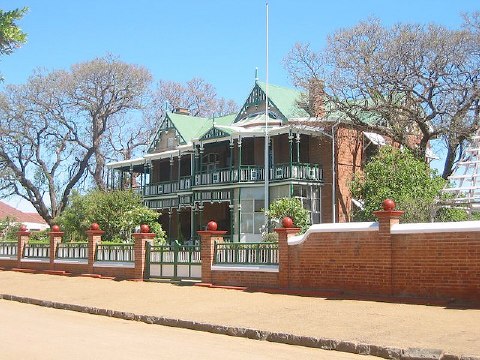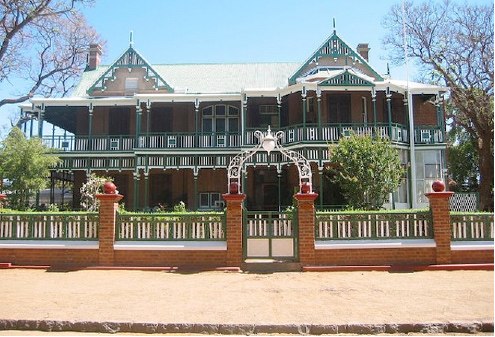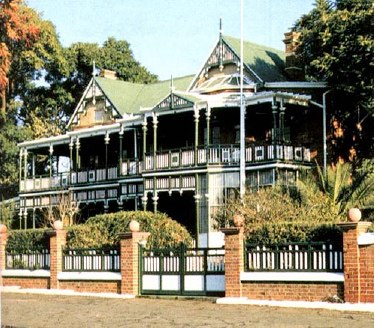Kimberley, South Africa
Lillianville – later Dunluce
The Home of Gustav Bonas in KIMBERLEY
It’s hard to find much information about or any pictures of Gustav Bonas one of the earliest successful Diamond dealers in Kimberley, however we do have some lovely pictures and information about his house.
10 Lodge Road, Belgravia, Kimberley, 8301, Northern Cape, South Africa is arguably the stateliest of homes ever built in Kimberley. It was Gustav Bonas who instructed the distinguished architect D W Greatbach to design a house fit for a member of the Diamond Syndicate. He was not disappointed; when the house was completed 1897. It perfectly reflected the prosperity of the Diamond Magnates of the period.
Gustav Bonas was not only a prominent diamond dealer and member of the Diamond Syndicate, he was a director of the daily newspaper, the Diamond Fields Advertiser and also a prominent member of Griqualand West Hebrew Congregation established in 1873. It was probably he who was instrumental in commissioning Greatbach to design a synagogue on land donated by the De Beers Company a few years later. Bonas’ name is on the foundation stone of the magnificent Memorial Road Synagogue which was consecrated in 1902 and he served as its first President jointly with David Harris.
The house was originally named Gustav Bonas House or Lillianville after Gustav’s wife. This late-Victorian mansion residence is double-storeyed (unusual for Kimberley) and has a magnificent decorative wooden fretwork wrap-around verandah.
On the original plans, the ground floor consisted of a vestibule, hall, dining room, pantry, larder, scullery, kitchen, servery, wine room, breakfast room and drawing room.
Upstairs are four bedrooms, two dressing rooms, a bathroom, linen room, drawing room and balcony. It’s original bathroom with its shower-cum-bath and brass towel rails fascinates visitors today.
During the siege of Kimberley the Boer forces fired a shell from Carter’s Ridge and aimed it at Cecil John Rhodes, who was staying at the nearby Sanatorium. The aim was good but the shell fell short and hit Lillianville instead. The red dining room suffered a direct hit by the ‘Long Tom’ shell and was severely damaged. It tore through the room and a damaged coal scuttle still stands there today.
This house is one of Kimberley’s most elegant buildings and amazingly much of the original fittings and furnishings remain in the house to this day.
In October 1902 Bonas sold the house including furniture and fittings to merchant John Orr for the mighty price of £6,487. The Orr family moved into the house in 1903. John Orr re-named the house Dunluce, meaning ‘strong fortress’, after a ruined castle in the country of his birth, Northern Ireland.
Orr had some to South Africa in 1881 to work for John Garlik who established a department store in Cape Town. Orr later came to Kimberley and in 1885 opened the first department store there, bearing his own name ‘John Orr’s’ in Jones Street. His business was very successful and he went on to establish branches of John Orrs in Durban, Johannesburg, Benoni, Lourenco Marques and Springs.
John Orr was deeply involved with church and civic affairs. He served as Mayor of Kimberley twice, from 1909 to 1910 and again from 1916 to 1918. In 1910 he issued Kimberley Souvenir Cups to celebrate the formation of the Union of South Africa. He was the founder of the Kimberley Horticultural Society and was a member of the first Management Board of the Alexander McGregor Memorial Museum, (which now is responsible for taking care of Dunluce) In 1918 he was awarded an MBE.
Orr married Mary Ellen Harper in 1892. They had five children. In 1894 John Wilfred was born. He followed in his father’s footsteps and also became mayor of Kimberley. In 1896 Robert Harold was born, in 1898 Gladys Eileen, in 1899 Alfred Norman and in 1907 Constance Maureen.
John Orr died in 1932 in Dublin whilst on holiday with his wife and youngest daughter Mollie. His daughter, Eileen who married pharmacist Lionel Cooper, lived on at Dunluce with her mother until her own death 1973. The portraits in the drawing room are of Eileen’s daughters, Rosemary (1928 - 1990) and June (born 1934), and June’s sons, Craig and Glenn.
After Eileen’s death, Dunluce was purchased by the major firm Barlow Rand Pty Ltd in 1975. The company restored the house and donated it to the McGregor Museum. Between 1975 and 1985 the Barlow manager in Kimberley would stay in Dunluce and members of the public could see the house on Thursdays by appointment. It was declared a national monument in 1982.
When Barlows withdrew from Kimberley, Dunluce was handed over to the McGregor Museum. (In 2003 De Beers Consolidated Mines offered to buy the house from the museum for R750 000. The idea was to restore the house and make it into a guest house, which meant it would have been well-kept and open to the public. The museum declined.)
The house still contains the fittings and furnishings left by the Orr family, as well as some from the Bonas family. Dunluce can be seen by the public by appointment and is unfortunately in desperate need of renovations.
Here is a picture of the house in the early 1900s – probably still called Lilianville at the time, in honour of Gustav Bonas’ wife.
To read an article on the fate and restoration of Lilianville/Dunluce in the 1970s, click here





Gustav Bonas








